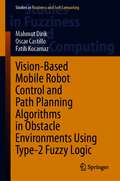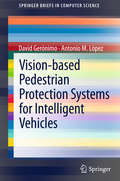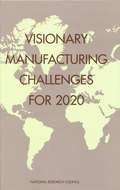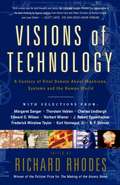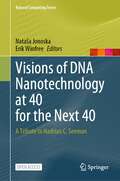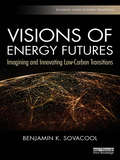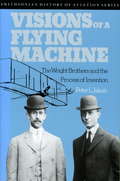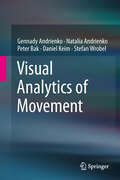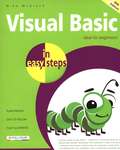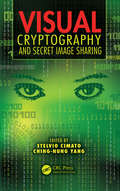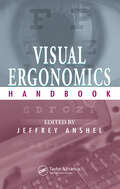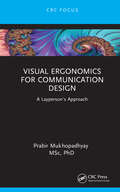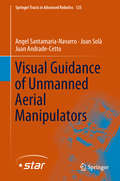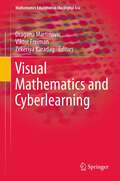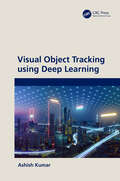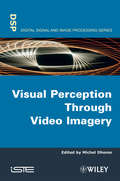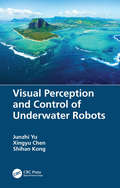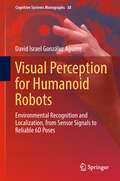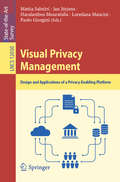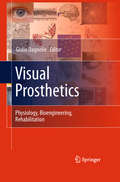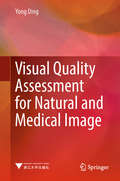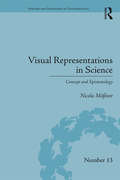- Table View
- List View
Vision-Based Mobile Robot Control and Path Planning Algorithms in Obstacle Environments Using Type-2 Fuzzy Logic (Studies in Fuzziness and Soft Computing #407)
by Oscar Castillo Mahmut Dirik Fatih KocamazThe book includes topics, such as: path planning, avoiding obstacles, following the path, go-to-goal control, localization, and visual-based motion control. The theoretical concepts are illustrated with a developed control architecture with soft computing and artificial intelligence methods. The proposed vision-based motion control strategy involves three stages. The first stage consists of the overhead camera calibration and the configuration of the working environment. The second stage consists of a path planning strategy using several traditional path planning algorithms and proposed planning algorithm. The third stage consists of the path tracking process using previously developed Gauss and Decision Tree control approaches and the proposed Type-1 and Type-2 controllers. Two kinematic structures are utilized to acquire the input values of controllers. These are Triangle Shape-Based Controller Design, which was previously developed and Distance-Based Triangle Structure that is used for the first time in conducted experiments. Four different control algorithms, Type-1 fuzzy logic, Type-2 Fuzzy Logic, Decision Tree Control, and Gaussian Control have been used in overall system design. The developed system includes several modules that simplify characterizing the motion control of the robot and ensure that it maintains a safe distance without colliding with any obstacles on the way to the target. The topics of the book are extremely relevant in many areas of research, as well as in education in courses in computer science, electrical and mechanical engineering and in mathematics at the graduate and undergraduate levels.
Vision-based Pedestrian Protection Systems for Intelligent Vehicles
by Antonio M. López David GerónimoPedestrian Protection Systems (PPSs) are on-board systems aimed at detecting and tracking people in the surroundings of a vehicle in order to avoid potentially dangerous situations. These systems, together with other Advanced Driver Assistance Systems (ADAS) such as lane departure warning or adaptive cruise control, are one of the most promising ways to improve traffic safety. By the use of computer vision, cameras working either in the visible or infra-red spectra have been demonstrated as a reliable sensor to perform this task. Nevertheless, the variability of human's appearance, not only in terms of clothing and sizes but also as a result of their dynamic shape, makes pedestrians one of the most complex classes even for computer vision. Moreover, the unstructured changing and unpredictable environment in which such on-board systems must work makes detection a difficult task to be carried out with the demanded robustness. In this brief, the state of the art in PPSs is introduced through the review of the most relevant papers of the last decade. A common computational architecture is presented as a framework to organize each method according to its main contribution. More than 300 papers are referenced, most of them addressing pedestrian detection and others corresponding to the descriptors (features), pedestrian models, and learning machines used. In addition, an overview of topics such as real-time aspects, systems benchmarking and future challenges of this research area are presented.
Visionary Manufacturing Challenges for 2020
by Committee on Visionary Manufacturing ChallengesManufacturing will unquestionably be a very different enterprise in 2020 from what it is today. This book presents an exciting picture of the profitable and productive potential of manufacturing two decades hence.This book takes an international view of future manufacturing that considers the leaps and bounds of technological innovation and the blurring of the lines between the manufacturing and service industries. The authors identify ten strategic technology areas as the most important for research and development and they recommend ways to address crosscutting questions. Representing a variety of industries, the authors identify six "grand challenges" that must be overcome for their vision to be realized, including the human/technology interface, environmental concerns, and miniaturization.A host of issues are discussed that will push and pull at manufacturing over the next 20 years: the changing workforce, the changing consumer, the rise of bio- and nanotechnology, the prospects for waste-free processing, simulation and modeling as design tools, shifts in global competition, and much more.The information and analyses in this book will be vitally important to everyone concerned about the future of manufacturing: policymakers, executives, design and engineering professionals, researchers, faculty, and students.
Visions Of Technology: A Century Of Vital Debate About Machines Systems A
by Richard RhodesTechnology was the blessing and the bane of the twentieth century. Human life span nearly doubled in the West, but in no century were more human beings killed by new technologies of war. Improvements in agriculture now feed increasing billions, but pesticides and chemicals threaten to poison the earth. Does technology improve us or diminish us? Enslave us or make us free? With this first-ever collection of the essential twentieth-century writings on technology, Pulitzer Prize-winning historian Richard Rhodes explores the optimism, ambivalence, and wrongheaded judgments with which Americans have faced an ever-shifting world.Visions of Technology collects writings on events from the Great Exposition of 1900 and the invention of the telegraph to the advent of genetic counseling and the defeat of Garry Kasparov by IBM's chess-playing computer, Deep Blue. Its gems of opinion and history include Henry Ford on the horseless carriage, Robert Caro on the transformation of New York City, J. Robert Oppenheimer on science and war, Loretta Lynn on the Pill and much more. Together, they chronicle an unprecedented century of change.
Visions and Concepts for Education 4.0: Proceedings of the 9th International Conference on Interactive Collaborative and Blended Learning (ICBL2020) (Advances in Intelligent Systems and Computing #1314)
by Michael E. Auer Dan CenteaThis book contains papers in the fields of Interactive, Collaborative, and Blended Learning; Technology-Supported Learning; Education 4.0; Pedagogical and Psychological Issues. With growing calls for affordable and quality education worldwide, we are currently witnessing a significant transformation in the development of post-secondary education and pedagogical practices. Higher education is undergoing innovative transformations to respond to our urgent needs. The change is hastened by the global pandemic that is currently underway. The 9th International Conference on Interactive, Collaborative, and Blended Learning: Visions and Concepts for Education 4.0 was conducted in an online format at McMaster University, Canada, from 14th to 15th October 2020, to deliberate and share the innovations and strategies. This conference’s main objectives were to discuss guidelines and new concepts for engineering education in higher education institutions, including emerging technologies in learning; to debate new conference format in worldwide pandemic and post-pandemic conditions; and to discuss new technology-based tools and resources that drive the education in non-traditional ways such as Education 4.0. Since its beginning in 2007, this conference is devoted to new learning approaches with a focus on applications and experiences in the fields of interactive, collaborative, and blended learning and related new technologies. Currently, the ICBL conferences are forums to exchange recent trends, research findings, and disseminate practical experiences in collaborative and blended learning, and engineering pedagogy. The conference bridges the gap between ‘pure’ scientific research and the everyday work of educators. Interested readership includes policymakers, academics, educators, researchers in pedagogy and learning theory, school teachers, industry-centric educators, continuing education practitioners, etc.
Visions of DNA Nanotechnology at 40 for the Next 40: A Tribute to Nadrian C. Seeman (Natural Computing Series)
by Nataša Jonoska Erik WinfreeThis open access book provides a unique and state-of-the-art view on DNA nanotechnology with an eye toward future developments. Intended as a tribute to Nadrian C. Seeman, who founded the field of DNA nanotechnology, the content is an exciting mixture of technical and non-technical material, reviews, tutorials, perspectives, new findings, and open questions. The book aims to inspire current researchers to sit back and think about the big picture, while also enticing new researchers to enter the field. Most of all, the book captures voices from a unique moment in time: 40 years after the publication of the first paper that envisioned DNA nanotechnology.From this vantage point, what are the untold stories, the unspoken concerns, the underlying fundamental issues, the overlooked opportunities, and the unifying grand challenges? What will help us see more clearly, see more creatively, or see farther? What is transpiring right now that could pave the way for the future? To address these questions, leading researchers have contributed 22 chapters, grouped into five sections: perspectives, chemistry and physics, structures, biochemical circuits, and spatial systems.This book will be an important reference point in the field of DNA nanotechnology, both for established researchers looking to take stock of the field and its future, and for newcomers such as graduate students and researchers in other fields who are beginning to appreciate the power and applicability of its methods.
Visions of Energy Futures: Imagining and Innovating Low-Carbon Transitions (Routledge Studies in Energy Transitions)
by Benjamin K. SovacoolThis book examines the visions, fantasies, frames, discourses, imaginaries, and expectations associated with six state-of-the-art energy systems—nuclear power, hydrogen fuel cells, shale gas, clean coal, smart meters, and electric vehicles—playing a key role in current deliberations about low-carbon energy supply and use. Visions of Energy Futures: Imagining and Innovating Low-Carbon Transitions unveils what the future of energy systems could look like, and how their meanings are produced, often alongside moments of contestation. Theoretically, it analyzes these technological case studies with emerging concepts from various disciplines: utopianism (history of technology), symbolic convergence (communication studies), technological frames (social construction of technology), discursive coalitions (discourse analysis and linguistics), sociotechnical imaginaries (science and technology studies), and the sociology of expectations (innovation studies, future studies). It draws from these cases to create a synthetic set of dichotomies and frameworks for energy futures based on original data collected across two global epistemic communities— nuclear physicists and hydrogen engineers—and experts in Eastern Europe and the Nordic region, stakeholders in South Africa, and newspapers in the United Kingdom. This book is motivated by the premise that tackling climate change via low-carbon energy systems and practices is one of the most significant challenges of the twenty-first century, and that success will require not only new energy technologies, but also new ways of understanding language, visions, and discursive politics. The discursive creation of the energy systems of tomorrow are propagated in polity, hoping to be realized as the material fact of the future, but processed in conflicting ways with underlying tensions as to how contemporary societies ought to be ordered. This book will be essential reading for students and scholars of energy policy, energy and environment, and technology assessment.
Visions of a Flying Machine
by Peter L. JakabThis acclaimed book on the Wright Brothers takes the reader straight to the heart of their remarkable achievement, focusing on the technology and offering a clear, concise chronicle of precisely what they accomplished and how they did it. This book deals with the process of the invention of the airplane and how the brothers identified and resolved a range of technical puzzles that others had attempted to solve for a century.Step by step, the book details the path of invention (including the important wind tunnel experiments of 1901) which culminated in the momentous flight at Kitty Hawk in 1903, the first major milestone in aviation history. Enhanced by original photos, designs, drawings, notebooks, letters and diaries of the Wright Brothers, Visions of a Flying Machine is a fascinating book that will be of interest to engineers, historians, enthusiasts, or anyone interested in the process of invention.
Visual Analytics of Movement
by Gennady Andrienko Natalia Andrienko Peter Bak Daniel Keim Stefan WrobelMany important planning decisions in society and business depend on proper knowledge and a correct understanding of movement, be it in transportation, logistics, biology, or the life sciences. Today the widespread use of mobile phones and technologies like GPS and RFID provides an immense amount of data on location and movement. What is needed are new methods of visualization and algorithmic data analysis that are tightly integrated and complement each other to allow end-users and analysts to extract useful knowledge from these extremely large data volumes. This is exactly the topic of this book. As the authors show, modern visual analytics techniques are ready to tackle the enormous challenges brought about by movement data, and the technology and software needed to exploit them are available today. The authors start by illustrating the different kinds of data available to describe movement, from individual trajectories of single objects to multiple trajectories of many objects, and then proceed to detail a conceptual framework, which provides the basis for a fundamental understanding of movement data. With this basis, they move on to more practical and technical aspects, focusing on how to transform movement data to make it more useful, and on the infrastructure necessary for performing visual analytics in practice. In so doing they demonstrate that visual analytics of movement data can yield exciting insights into the behavior of moving persons and objects, but can also lead to an understanding of the events that transpire when things move. Throughout the book, they use sample applications from various domains and illustrate the examples with graphical depictions of both the interactive displays and the analysis results. In summary, readers will benefit from this detailed description of the state of the art in visual analytics in various ways. Researchers will appreciate the scientific precision involved, software technologists will find essential information on algorithms and systems, and practitioners will profit from readily accessible examples with detailed illustrations for practical purposes.
Visual Basic in Easy Steps: Updated for Visual Basic 2019
by Mike McGrathVisual Basic in easy steps, 6th edition gives you code examples, screenshots, and step-by-step instructions that illustrate each aspect of Visual Basic so you'll be creating your own interactive applications in no time!. <p><p> You need have no previous knowledge of any programming language so it's ideal if you're a newcomer to Windows programming. Each chapter builds your knowledge of Visual Basic. By the end of this book you will have gained a sound understanding of Visual Basic programming and be able to create your own interactive applications. <p><p> Visual Basic in easy steps, 6th edition has an easy-to-follow style that will appeal to anyone who wants to begin Windows programming. It will appeal to programmers who want to quickly learn the latest Visual Basic techniques, and to the student who is studying computing at school or college, and to those seeking a career in Information Technology who needs a thorough understanding of Visual Basic programming.
Visual Cryptography and Secret Image Sharing
by Ching-Nung Yang Stelvio CimatoWith rapid progress in Internet and digital imaging technology, there are more and more ways to easily create, publish, and distribute images. Considered the first book to focus on the relationship between digital imaging and privacy protection, Visual Cryptography and Secret Image Sharing is a complete introduction to novel security methods and sharing-control mechanisms used to protect against unauthorized data access and secure dissemination of sensitive information. Image data protection and image-based authentication techniques offer efficient solutions for controlling how private data and images are made available only to select people. Essential to the design of systems used to manage images that contain sensitive data—such as medical records, financial transactions, and electronic voting systems—the methods presented in this book are useful to counter traditional encryption techniques, which do not scale well and are less efficient when applied directly to image files. An exploration of the most prominent topics in digital imaging security, this book discusses: Potential for sharing multiple secrets, Visual cryptography schemes—based either on the probabilistic reconstruction of the secret image, or on different logical operations for combining shared images, Inclusion of pictures in the distributed shares, Contrast enhancement techniques, Color-image visual cryptography, Cheating prevention, Alignment problems for image shares, Steganography and authentication In the continually evolving world of secure image sharing, a growing number of people are becoming involved as new applications and business models are being developed all the time. This contributed volume gives academicians, researchers, and professionals the insight of well-known experts on key concepts, issues, trends, and technologies in this emerging field.
Visual Ergonomics Handbook
by Jeffrey AnshelViewing an electronic display screen varies significantly from reading text on paper and human eyes often suffer for it. Featuring cutting-edge research in the field of visual ergonomics, Visual Ergonomics Handbook focuses on vision and eye-care issues in both the office and industrial setting, including eye safety issues in industrial plants and c
Visual Ergonomics for Communication Design: A Layperson's Approach
by Prabir MukhopadhyayVisual Ergonomics for Communication Design reveals the application of ergonomics principles in visual communication design. It enables the visual designer to look at different aspects of visual design from the point of view of the user to ensure that their designs are more user-friendly. The book allows the reader to apply the principles of ergonomics in different facets of communication design such as pictograms, icons and logo design, product labeling, information system in space, and visual ergonomics in simple map design. An introductory chapter allows the reader to learn the basics and principles of visual ergonomics and gives them an insight into the probable application areas. Further chapters delve deeper into the topic with each chapter ending with "Key Points", Practice Sections", and exercises designed to help the reader to revise what they have learned. The reader will benefit from coverage of visual ergonomics in icons, pictograms, and symbols, product labeling, wayfinding in space, and map design which are all backed up with examples and illustrations. Written with the layperson in mind who has no background in the subject, this interesting and easy-to-read reference addresses how to use the different principles of ergonomics in visual communication in a storytelling format. With a narrative structure to the chapters and illustrated throughout, this book is an ideal read for students and professionals looking to strengthen their knowledge of visual communication design by augmenting it with ergonomic principles. It will appeal to students and professionals studying and working in the fields of computer science, human-computer interaction, design engineering, mechanical engineering, information technology, communications engineering, and human factors engineering.
Visual Guidance of Unmanned Aerial Manipulators (Springer Tracts in Advanced Robotics #125)
by Juan Andrade-Cetto Angel Santamaria-Navarro Joan SolàThis monograph covers theoretical and practical aspects of the problem of autonomous guiding of unmanned aerial manipulators using visual information. For the estimation of the vehicle state (position, orientation, velocity, and acceleration), the authors propose a method that relies exclusively on the use of low-cost and highrate sensors together with low-complexity algorithms. This is particularly interesting for applications in which on board computation with low computation power is needed. Another relevant topic covered in this monograph is visual servoing. The authors present an uncalibrated visual servo scheme, capable of estimating at run time, the camera focal length from the observation of a tracked target. The monograph also covers several control techniques, which achieve a number of tasks, such as robot and arm positioning, improve stability and enhance robot arm motions. All methods discussed in this monograph are demonstrated in simulation and through real robot experimentation. The text is appropriate for readers interested in state estimation and control of aerial manipulators, and is a reference book for people who work in mobile robotics research in general.
Visual Inference for IoT Systems: A Practical Approach
by Angel Rodríguez-Vázquez Jorge Fernández-Berni Delia Velasco-MonteroThis book presents a systematic approach to the implementation of Internet of Things (IoT) devices achieving visual inference through deep neural networks. Practical aspects are covered, with a focus on providing guidelines to optimally select hardware and software components as well as network architectures according to prescribed application requirements. The monograph includes a remarkable set of experimental results and functional procedures supporting the theoretical concepts and methodologies introduced. A case study on animal recognition based on smart camera traps is also presented and thoroughly analyzed. In this case study, different system alternatives are explored and a particular realization is completely developed. Illustrations, numerous plots from simulations and experiments, and supporting information in the form of charts and tables make Visual Inference and IoT Systems: A Practical Approach a clear and detailed guide to the topic. It will be of interest to researchers, industrial practitioners, and graduate students in the fields of computer vision and IoT.
Visual Mathematics and Cyberlearning
by Viktor Freiman Dragana Martinovic Zekeriya KaradagThis first book in the series will describe the Net Generation as visual learners who thrive when surrounded with new technologies and whose needs can be met with the technological innovations. These new learners seek novel ways of studying, such as collaborating with peers, multitasking, as well as use of multimedia, the Internet, and other Information and Communication Technologies. Here we present mathematics as a contemporary subject that is engaging, exciting and enlightening in new ways. For example, in the distributed environment of cyber space, mathematics learners play games, watch presentations on YouTube, create Java applets of mathematics simulations and exchange thoughts over the Instant Messaging tool. How should mathematics education resonate with these learners and technological novelties that excite them?
Visual Object Tracking using Deep Learning
by Ashish KumarThis book covers the description of both conventional methods and advanced methods. In conventional methods, visual tracking techniques such as stochastic, deterministic, generative, and discriminative are discussed. The conventional techniques are further explored for multi-stage and collaborative frameworks. In advanced methods, various categories of deep learning-based trackers and correlation filter-based trackers are analyzed. The book also: Discusses potential performance metrics used for comparing the efficiency and effectiveness of various visual tracking methods. Elaborates on the salient features of deep learning trackers along with traditional trackers, wherein the handcrafted features are fused to reduce computational complexity. Illustrates various categories of correlation filter-based trackers suitable for superior and efficient performance under tedious tracking scenarios. Explores the future research directions for visual tracking by analyzing the real-time applications. The book comprehensively discusses various deep learning-based tracking architectures along with conventional tracking methods. It covers in-depth analysis of various feature extraction techniques, evaluation metrics and benchmark available for performance evaluation of tracking frameworks. The text is primarily written for senior undergraduates, graduate students, and academic researchers in the fields of electrical engineering, electronics and communication engineering, computer engineering, and information technology.
Visual Perception Through Video Imagery (Digital Signal And Image Processing Ser.)
by Michel DhomeFor several decades researchers have tried to construct perception systems based on the registration data from video cameras. This work has produced various tools that have made recent advances possible in this area. Part 1 of this book deals with the problem of the calibration and auto-calibration of video captures. Part 2 is essentially concerned with the estimation of the relative object/capture position when a priori information is introduced (the CAD model of the object). Finally, Part 3 discusses the inference of density information and the shape recognition in images.
Visual Perception and Control of Underwater Robots
by Junzhi Yu Xingyu Chen Shihan KongVisual Perception and Control of Underwater Robots covers theories and applications from aquatic visual perception and underwater robotics. Within the framework of visual perception for underwater operations, image restoration, binocular measurement, and object detection are addressed. More specifically, the book includes adversarial critic learning for visual restoration, NSGA-II-based calibration for binocular measurement, prior knowledge refinement for object detection, analysis of temporal detection performance, as well as the effect of the aquatic data domain on object detection. With the aid of visual perception technologies, two up-to-date underwater robot systems are demonstrated. The first system focuses on underwater robotic operation for the task of object collection in the sea. The second is an untethered biomimetic robotic fish with a camera stabilizer, its control methods based on visual tracking. The authors provide a self-contained and comprehensive guide to understand underwater visual perception and control. Bridging the gap between theory and practice in underwater vision, the book features implementable algorithms, numerical examples, and tests, where codes are publicly available. Additionally, the mainstream technologies covered in the book include deep learning, adversarial learning, evolutionary computation, robust control, and underwater bionics. Researchers, senior undergraduate and graduate students, and engineers dealing with underwater visual perception and control will benefit from this work.
Visual Perception for Humanoid Robots: Environmental Recognition and Localization, from Sensor Signals to Reliable 6D Poses (Cognitive Systems Monographs #38)
by David Israel González AguirreThis book provides an overview of model-based environmental visual perception for humanoid robots. The visual perception of a humanoid robot creates a bidirectional bridge connecting sensor signals with internal representations of environmental objects. The objective of such perception systems is to answer two fundamental questions: What & where is it? To answer these questions using a sensor-to-representation bridge, coordinated processes are conducted to extract and exploit cues matching robot’s mental representations to physical entities. These include sensor & actuator modeling, calibration, filtering, and feature extraction for state estimation. This book discusses the following topics in depth: • Active Sensing: Robust probabilistic methods for optimal, high dynamic range image acquisition are suitable for use with inexpensive cameras. This enables ideal sensing in arbitrary environmental conditions encountered in human-centric spaces. The book quantitatively shows the importance of equipping robots with dependable visual sensing. • Feature Extraction & Recognition: Parameter-free, edge extraction methods based on structural graphs enable the representation of geometric primitives effectively and efficiently. This is done by eccentricity segmentation providing excellent recognition even on noisy & low-resolution images. Stereoscopic vision, Euclidean metric and graph-shape descriptors are shown to be powerful mechanisms for difficult recognition tasks. • Global Self-Localization & Depth Uncertainty Learning: Simultaneous feature matching for global localization and 6D self-pose estimation are addressed by a novel geometric and probabilistic concept using intersection of Gaussian spheres. The path from intuition to the closed-form optimal solution determining the robot location is described, including a supervised learning method for uncertainty depth modeling based on extensive ground-truth training data from a motion capture system.The methods and experiments are presented in self-contained chapters with comparisons and the state of the art. The algorithms were implemented and empirically evaluated on two humanoid robots: ARMAR III-A & B. The excellent robustness, performance and derived results received an award at the IEEE conference on humanoid robots and the contributions have been utilized for numerous visual manipulation tasks with demonstration at distinguished venues such as ICRA, CeBIT, IAS, and Automatica.
Visual Privacy Management: Design and Applications of a Privacy-Enabling Platform (Lecture Notes in Computer Science #12030)
by Haralambos Mouratidis Paolo Giorgini Mattia Salnitri Jan Jürgens Loredana ManciniPrivacy is a burden for most organizations, the more complex and wider an organization is, the harder to manage and enforce privacy is.GDPR and other regulations on privacy impose strict constraints that must be coherently enforced, considering also privacy needs of organization and their users. Furthermore, organizations should allow their users to express their privacy needs easily, even when the process that manages users' data is complex and involves multiple organizations.Many research work consider the problem using simplistic examples, with solutions proposed that never actually touch pragmatic problems of real, large organizations, with thousands of users and terabytes of personal and sensitive data.This book faces the privacy management problem targeting actual large organizations, such as public administrations, including stakeholders in the process of definition of the solution and evaluating the results with its actual integration in four large organizations. The contribution of this book is twofold: a privacy platform that can be customized and used to manage privacy in large organizations; and the process for the design of such a platform, from a state-of-the-art survey on privacy regulations, through the definition of its requirements, its design and its architecture, until the evaluation of the platform.
Visual Prosthetics
by Gislin DagnelieVisual Prosthetics provides an in-depth analysis of the principles of operation, current state, anticipated developments, and functional aspects of visual prosthetics restoring sight to visually impaired individuals. This volume uniquely describes the human visual system in health and disease in a pedagogical and didactic manner, fitting to professionals and researchers with a bioengineering background. Readers will find a balanced overview of electrical, molecular chemical and synthetic chromophore stimulation, in addition to the biophysics and psychological aspects of vision restoration. Unlike competitive texts, this introduction also includes the need and methods for functional evaluation and rehabilitation. Professionals in the field of biomedical engineering and graduate and postgraduate researchers will find Visual Prosthetics a valuable reference.
Visual Quality Assessment for Natural and Medical Image
by Yong DingImage quality assessment (IQA) is an essential technique in the design of modern, large-scale image and video processing systems. This book introduces and discusses in detail topics related to IQA, including the basic principles of subjective and objective experiments, biological evidence for image quality perception, and recent research developments. In line with recent trends in imaging techniques and to explain the application-specific utilization, it particularly focuses on IQA for stereoscopic (3D) images and medical images, rather than on planar (2D) natural images. In addition, a wealth of vivid, specific figures and formulas help readers deepen their understanding of fundamental and new applications for image quality assessment technology. This book is suitable for researchers, clinicians and engineers as well as students working in related disciplines, including imaging, displaying, image processing, and storage and transmission. By reviewing and presenting the latest advances, and new trends and challenges in the field, it benefits researchers and industrial R&D engineers seeking to implement image quality assessment systems for specific applications or design/optimize image/video processing algorithms.
Visual Representations in Science: Concept and Epistemology (History and Philosophy of Technoscience)
by Nicola MößnerVisual representations (photographs, diagrams, etc.) play crucial roles in scientific processes. They help, for example, to communicate research results and hypotheses to scientific peers as well as to the lay audience. In genuine research activities they are used as evidence or as surrogates for research objects which are otherwise cognitively inaccessible. Despite their important functional roles in scientific practices, philosophers of science have more or less neglected visual representations in their analyses of epistemic methods and tools of reasoning in science. This book is meant to fill this gap. It presents a detailed investigation into central conceptual issues and into the epistemology of visual representations in science.
Visual Research Methods in Educational Research
by Barbara Pini Julianne MossHave you noticed there is a burgeoning take up of visual research in education? Are you considering using visual research as part of your next research project or revitalising your research methods course? For researchers who are new to the field of VRMs in education there is little critical literature on the subject. This book addresses the gap in the literature and brings together some of the leading educational researchers engaging and reflecting on the visual from Australia, the UK and Canada. Encapsulated in a single volume, this book sets out theoretically grounded discussions of the possibilities and challenges of the approach for educational researchers around four key themes: images of schooling, performing pedagogy, power and representation and ethical issues in educational research.
